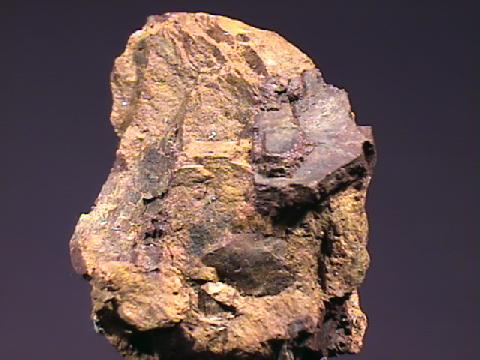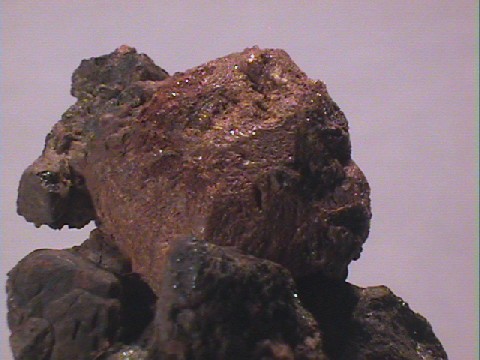 THE
MINERAL THORITE
THE
MINERAL THORITE
- Chemistry: (Th, U)SiO4, Thorium Uranium Silicate.
- Class: Silicates
- Subclass: Nesosilicates
- Uses: As a minor ore of thorium and uranium and as mineral specimens.
Specimens
Thorite is the most common thorium mineral. Thorium is a highly radioactive element and could be used as a replacement for uranium in nuclear power generation. It is estimated to be three times as common as uranium and all the thorium in the Earth's crust could have more potential energy than both uranium and the fossil fuel reserves combined. Uranium and thorium are considered to be the primary sources of the internal heat of the Earth through their radioactive decay.
Although thorite is the most common thorium mineral, it is not the primary
ore of thorium. The phosphate
mineral monazite
has an average of about 6% thorium in its composition that includes several
rare earth elements. Enough monazite is mined to supply most of the current
thorite demand. If monazite deposits become scarce or the demand for thorium
increases, then thorite and to lesser extents other thorium bearing minerals
such as
Thorite is currently an important ore of uranium. A variety of thorite
often called "uranothorite" is particularly rich in uranium
and has been a viable uranium ore at Bancroft, Ontario, Canada. Other varieties
of thorite include "orangite", an orange variety; "calciothorite"
an impure variety with trace amounts of calcium and "freyalite"
actually a discredited variety containing cerium (it turned out to be an
altered form of the mineral
There is a closely related mineral to thorite called thorogummite that was once considered a variety of thorite but is now known to be an alteration product of thorite. Thorogummite has some of the SiO4 tetrahedrons replaced by four hydroxides for a formula that looks like:
(Th, U)2(SiO4)(2 - X)(OH)4X
The X represents the conversion of one silicate tetrahedron with a negative four charge (-4) to four hydroxides with a negative one charge (-1) each. So that if half the silicate tetrahedrons are replaced by the four hydroxides, where X = 1, the formula would look like this:
(Th, U)2SiO4(OH)4
Thorite also is related to a mineral called huttonite. Thorite and huttonite
are dimorphs (di means two and morph means shape). The two minerals have the same chemistry, they just have
different structures.
A similar situation occurs with the dimorphism of
diamond
and graphite,
both of whom are composed of carbon, but have very different
structures. Huttonite ironically belongs in the
Because thorite is highly radioactive, specimens are often metamict. This is a condition found in radioactive minerals and results from the destructive effects of its own radiation on its crystal lattice. The effect can destroy a crystal lattice completely while leaving the outward appearance unchanged. Thorogummite is believed to be formed from thorite by hydration which is facilitated by metamictation.
Specimens of thorite generally come from igneous pegmatites and volcanic extrusive rocks, hydrothermal veins, contact metamorphic rocks, and as small grains found in detrital sands. Crystals are rare, but when found can produce nicely shaped short prismatic crystals with pyramidal terminations. Remember, this is a radioactive mineral and should be stored away from other minerals that are subject to damage from radioactivity and of course human exposure should be limited !
PHYSICAL CHARACTERISTICS:
- Color is normally black, but also brownish black, orange, yellowish-orange and dark green.
- Luster is resinous.
- Transparency: Crystals are opaque.
- Crystal System is tetragonal; 4/m 2/m 2/m
- Crystal Habits include short prismatic crystals with a square cross-section and simple pyramidal terminations. Also massive, embedded irregular grains and reniform.
- Cleavage is poor, in two directions lengthwise, but is rarely seen.
- Fracture is conchoidal.
- Hardness is 4.5 - 5
- Specific Gravity is 4.1 - near 7.
- Streak is orange to brown.
- Other Characteristics: Nearly always metamict and always strongly radioactive.
- Associated Minerals include quartz, feldspars, biotite and betafite.
- Notable Occurrences are found at Langesundfjord, Norway; Bancroft, Ontario, Canada; Eifel District, Germany and Arizona, USA.
- Best Field Indicators are color, luster, crystal habit, fracture and especially radioactivity.












